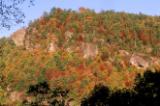Using Conservation Forestry to Preserve a Legacy by Donna Alexander
In 1995, a grand discovery was made on a hidden tract of land within the vast 110-mile forested corridor of Pine Mountain in southeastern Kentucky. This more than 3,000-acre tract, known today as the Blanton Forest State Nature Preserve, is the largest old-growth remnant forest remaining in the state. Mixed mesophytic forests like Blanton represent the most diverse hardwood forests remaining on Earth—a habitat type that once dominated Kentucky’s Appalachian Plateau and survives on much of Pine Mountain today.
Around this discovery, a land trust was formed. The then nascent Kentucky Natural Lands Trust (KNLT) successfully raised $3 million to purchase this old-growth tract before transferring it to the Kentucky State Nature Preserves Commission. Blanton Forest now enjoys the highest protection status available for public lands in the state of Kentucky. The success and overwhelming support for this project gave KNLT the momentum to continue its conservation efforts in Kentucky.
Today, KNLT’s 16-member Board of Directors, three full-time staff members and many partners have preserved thousands of acres of forestland in southeastern Kentucky, with a special emphasis on the biologically rich ridge of Pine Mountain.
Protecting a Legacy
The Pine Mountain Legacy Project is a landscape level undertaking focused on protecting one of the largest contiguous blocks of forestland remaining in Kentucky. A true gem, Pine Mountain already boasted significant public conservation acreage. Crossed by only six paved roads, the mountain’s 150,000 acres are a refuge for a third of Kentucky’s rare and endangered plant and animal species, including the endangered Indiana bat. Further, its uninterrupted ridgeline provides a migratory corridor for terrestrial wildlife and birds.
The Pine Mountain Legacy Project aims to maintain the largely intact forestlands blanketing this ridge. With it, they will preserve a rare and intact ecosystem as well as a vital north/south migratory corridor that is becoming increasingly important for species impacted by climate change.
A Conservation Vision
KNLT’s protection strategy hinges on two primary mechanisms -- protect highly sensitive ecological areas through land acquisition and maintain surrounding lands through conservation forestry easements. To date, this has been an effective strategy since KNLT has been able to purchase large blocks of important rural land in the region for $400 to $700 per acre. Even at these prices their mission is not to acquire everything, however, but rather to reach out to the numerous smaller acreage landowners to engage them in their conservation vision.
Most smaller tracts (1 to 40 acres) are owned by private individuals engaged in non-industrial timber operations. The growing and processing of privately grown timber is one of the largest agricultural and natural resource industries in Kentucky, which ranks in the top three hardwood-lumber-producing states in the country. Despite the importance of this industry to the region, forest management assistance and education for private landowners is minimal. KNLT aims to fill this role, recognizing that by meeting the needs of these individuals, landowners can become important players in landscape-scale conservation.
Building a Conservation Forestry Community
With support from a number of funders, including a Living Lands Biodiversity Grant, and a partnership with Mountain Association for Community Economic Development (MACED), KNLT is promoting a new conservation forestry program to private forest managers in the region. Conservation forestry emphasizes the importance of soil and water quality, ecological diversity, wildlife habitat and overall forest health, while producing high-value timber products for a wide range of commercial opportunities.
KNLT has developed a pilot project that will assist low-to moderate-income landowners in realizing greater economic and environmental benefits from their forestlands. Through this pilot, MACED has become an aggregator with the Chicago Climate Exchange (CCX), a voluntary, legally binding greenhouse gas reduction and trading system. As an approved CCX offset aggregator, MACED will enroll thousands of acres of private forested land in eastern Kentucky and central Appalachia in a carbon sequestration project that promotes conservation forestry and offers alternative annual income for landowners through carbon offset projects.
KNLT is launching their Conservation Forestry Project on Daniel’s Mountain, a 700-acre tract of historically mismanaged timberland that will serve as a demonstration forest. They have certified and enrolled the tract through MACED and will receive reimbursement for the carbon offsets from the CCX. KNLT will draft language for working forest conservation easements, target landowners interested in managing their forest land in conservation-minded ways and teach them the management steps needed to improve forest health and timber quality. The management recommendations and working forest conservation easement language developed through this project will be used by forest landowners on Pine Mountain and ultimately by land managers throughout the state and nationally.
A Win-Win-Win
Through the conservation forestry project, KNLT is able to demonstrate that conservation forestry practices have both economic as well as biodiversity value. A true win-win-win for landowners, wildlife and our environment, this project is preserving local economies and culture, absorbing harmful carbon from our atmosphere and maintaining a vital migratory corridor with some of the most biologically diverse forest habitats in the world. And this is only the beginning. KNLT plans to use its experience on Pine Mountain to promote conservation forestry throughout the state and to assist other land trusts in using it to achieve landscape-scale conservation.
Donna Alexander is the program manager of the Kentucky Natural Lands Trust.







